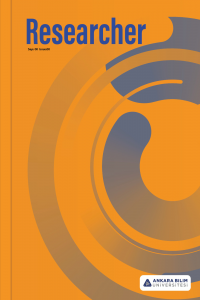Kadın Yoksulluğuna Karşı Mücadelede Çeşitli Ülke Uygulamaları
Yoksulluk Kadın Yoksulluğu Yoksullukla Mücadele Politikaları Cinsiyet Eşitsizliği
Various Country Applications in the Struggle Against Women's Poverty
___
- Açıkgöz, R. (2010). Kadın yoksulluğu üzerine bir inceleme. Yardım ve Dayanışma Dergisi, 1(2), Temmuz-Aralık, 45-60.
- Aktan, C. C. (2002). Yoksullukla mücadele stratejileri, Hak-İş Konfederasyonu Yayınları.
- Buvinic, M. (1998). Women in poverty: a new global underclass. Foreign Policy, July.
- Chakravarty, S. R., D’Ambrosio, C. (2006). The measurement of social exclusion. Review of Income and Wealth, 52(3), 377-398.
- Citro, C.. F., Michael, R. T. (1995). Measuring poverty: a new approach. National Academies Press.
- Clark, D. A. (2005). The capability approach: its development, critiques and recent advances. Global Poverty Research Group – WPS – 032.
- Cotter, D. A., Ovadia, S., Hermsen, J. M.,Vanneman, R.(2001). The glass ceiling effect. Social Forces, 80(2), 655-682.
- DuToit, A. (2004). ‘Social exclusion’ discourse and chronic poverty: a South African case study. Development and Change, 35(5), 987-1010.
- European Comission (2013). Barcelona Objectives, http://ec.europa.eu/justice/genderequality/files/documents/130531_barcelona_en.pdf adresinden erişildi. (Erişim tarihi: 19.12.2017)
- European Comission (2016). Strategic engagement for gender equality 2016-2019, http://ec.europa.eu/justice/gender-equality/document/files/strategic_engagement_en.pdf adresinden erişildi. (Erişim Tarihi: 14.12.2017)
- Eurostat Statistics (2017). http://ec.europa.eu/eurostat/statisticsexplained/index.php/Employment_statistics, adresinden erişildi. (Erişim Tarihi:10.12.2017)
- Haan, A. D.,Maxwell, S. (1998). Editorial: poverty and social exclusionin north and south. İds Bulletin, 29(1), 1-9.
- ILO. (2017). World employment and social outlook – trends 2017, http://www.ilo.org/wcmsp5/groups/public/---dgreports/---dcomm/--- publ/documents/publication/wcms_541211.pdf adresinden erişildi. (Erişim Tarihi: 20.12.2017)
- KEİG. (2013). Türkiye’de kadın emeği ve istihdamına yönelik politikalar, kadın emeği ve istihdamına dair politika ve faaliyetlerin 12 ilde değerlendirilmesi, http://www.keig.org/wpcontent/uploads/2016/03/genelge-kitap-2013.pdf adresinden erişildi. (Erişim Tarihi: 01.01.2018)
- Laderchi, R. C.,Saith, R., Stewart, F. (2003). Does it matter that we do not agree on the definition of poverty? A comparison off our approaches. Oxford Development Studies, 31(3), 243–274.
- Moghadam, V. M. (2005). The ‘feminization of poverty’ and women’s human rights, Social and Human Sciences, July.
- Nayak, A. (2016). Understanding the perceived causes of poverty and quality of life: a study of rourkela city. Humanities and Social Sciences National Institute of Technology Rourkela, Dissertation submitted in Partial Fulfillment of There Quirements of The Degree of Doctor of Philosophy.
- Nolan, B., Whelan, C. T. (1996). Measuring poverty using income and deprivation indicators: alternative approaches. Journal of European Social Policy, 6, 225-240.
- OECD. (2012). Women’s Economic Empowerment, http://www.oecd.org/dac/povertyreduction/50157530.pdf adresinden erişildi. (Erişim Tarihi: 29.12.2017)
- OECD WEEK. (2012). Gender Equality in education, employment and entrepreneurship: final report to the mcm 2012, https://www.oecd.org/els/soc/50423364.pdf adresinden erişildi. (Erişim Tarihi: 26.12.2017)
- Önder, N. (2013). Türkiye’de kadın işgücünün görünümü. ÇSGB Çalışma Dünyası Dergisi, 1(1), 35-61.
- Öztürk, M., Çetin, I. B. (2009). Dünyada ve Türkiye’de yoksulluk ve kadınlar. Journal of Yaşar University, 3(11), 2661-2698.
- Smeeding, T. M. (1977). The economic well-being of low income households: implications for income inequality and poverty. Improving Economic Measures of Well-being. New York: AcademicPress, pp 229-256.
- UNDP. (1995). Human development report 1995, http://hdr.undp.org/sites/default/files/reports/256/hdr_1995_en_complete_nostats.pdf adresinden erişildi. (Erişim Tarihi: 15.12.2017)
- UNDP. (1997). Human development report 1997, http://hdr.undp.org/sites/default/files/reports/258/hdr_1997_en_complete_nostats.pdf adresinden erişildi. (Erişim Tarihi: 12.12.2017)
- UNDP. (2016). Human development report 2016, http://hdr.undp.org/sites/default/files/2016_human_development_report.pdf adresinden erişildi. (Erişim Tarihi: 01.01.2018)
- UNHR. (2014). Women’s rights are human rights, http://www.ohchr.org/Documents/Events/WHRD/WomenRightsAreHR.pdf adresinden erişildi. (Erişim Tarihi: 14.12.2017)
- UN. (2015). The world's women 2015 trends and statistics. https://unstats.un.org/unsd/gender/downloads/worldswomen2015_report.pdf adresinden erişildi. (Erişim Tarihi: 25.12.2017)
- Washbrook, E., R., C. J.,Waldfogel, J., Han, W. (2011). Public policies, women’s employment after child bearing, and child well-being. B E J Econom Anal Policy, 11(1).
- Yakışık, H., Dölarslan, E. Ş., Şafak Zülfikar, B. (2017). A new scale of poverty: How the officially recorded poor people in Turkey perceive themselves. Development Policy Review, 35, 322-337.
- Yunus, M. (2003). Yoksulluğun bulunmadığı bir dünyaya doğru, (G. Şen, çev.), İstanbul: Doğan Kitapçılık İş Kanunu (2003). Resmi Gazete. Yayım Tarihi: 10.06.2003. Sayısı: 25134. Numarası: 4857
- ISSN: 2717-9494
- Yayın Aralığı: Yılda 2 Sayı
- Başlangıç: 2013
- Yayıncı: Ankara Bilim Üniversitesi
Toplumsal Belleğe Felsefi ve Edebi Yaklaşımlar: Nikos Kazancakis Örneği
Amerika’da Anne-Baba Eğitiminde Uygulanan Erken Müdahale Programları
Sosyal Uyum ile Psikolojik Belirti Arasındaki İlişkide Sosyal Yetkinlik İnancının Aracılık Rolü
Öner ÇELİKKALELİ, Mim Sertaç TÜMTAŞ
Veysel YILMAZ, Yasemin CAN, Hülya ŞEN
Anaokulunda Meslektaş Gözlem ve Yardımı; Neden ve Nasıl Yapılmalı?
Yağmur BAŞARAN, Süleyman GÖKSOY
Öğretmenlerin Denetim Sistemi İle İlgili Görüşlerinin Bazı Değişkenler Açısından İncelenmesi
Emel TERZİOĞLU BARIŞ, Mehmet ŞAHİN
Fıkhî Mezhepler ve Hüküm İstinbatında Dayandıkları Deliller; Ehl-i Sünnet-İmamiyye Karşılaştırması
Aslı AKMAN YOZGAT, Neslihan ÖZBEK, Özlem AFACAN
Kamusal Alan Bağlamında İletişim Teknolojileri ve Siyasal İletişim Arasındaki İlişki
